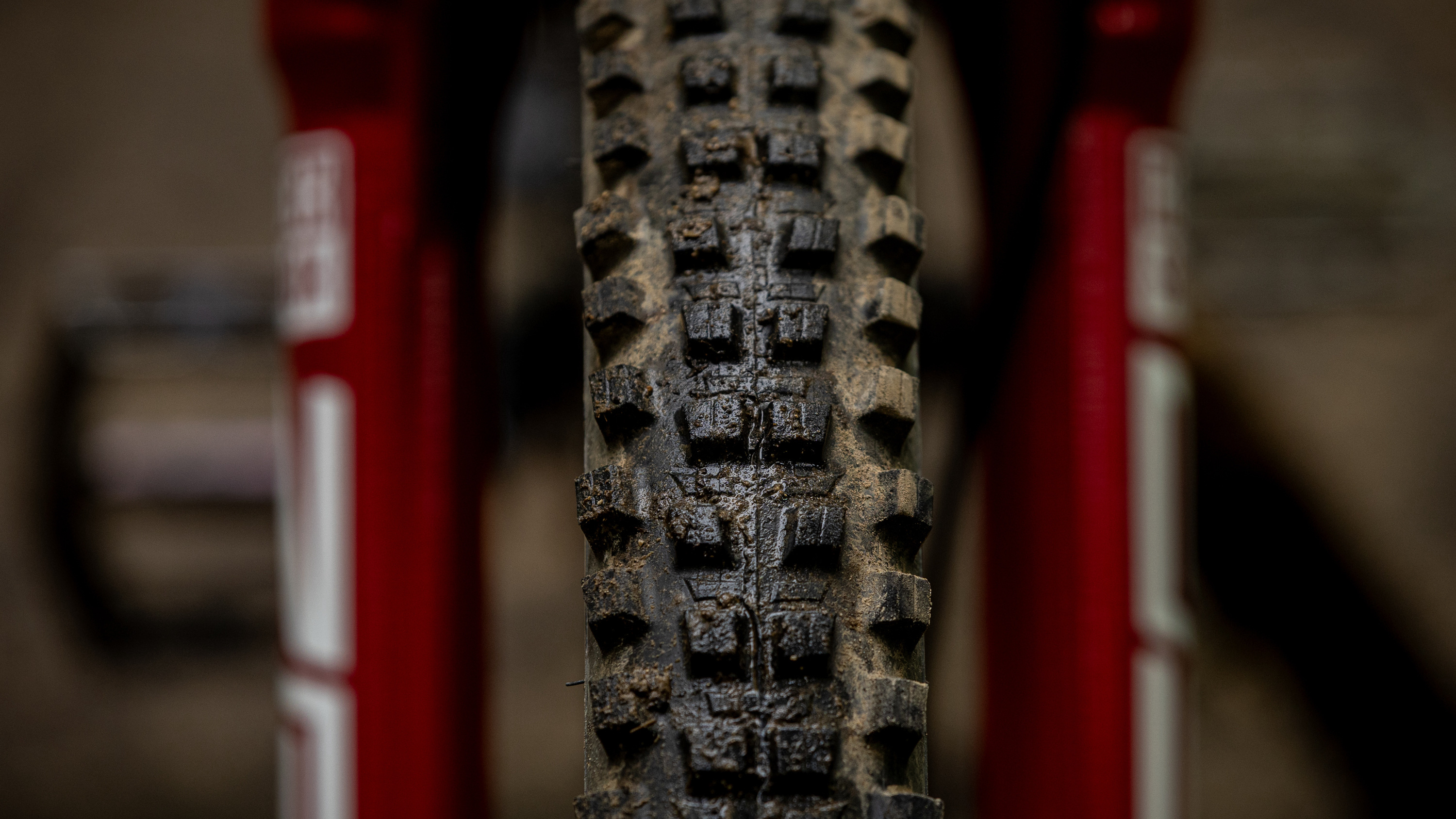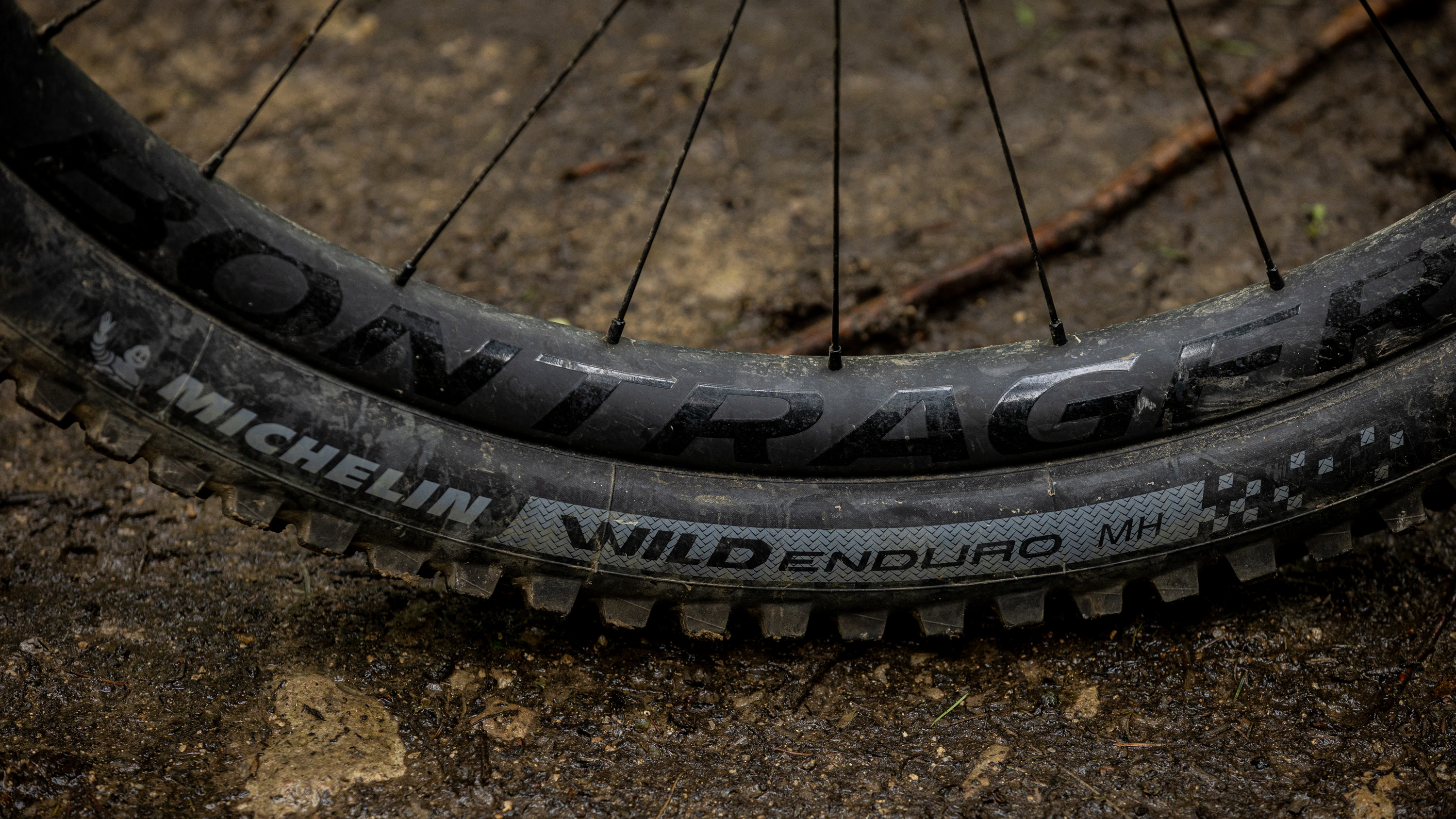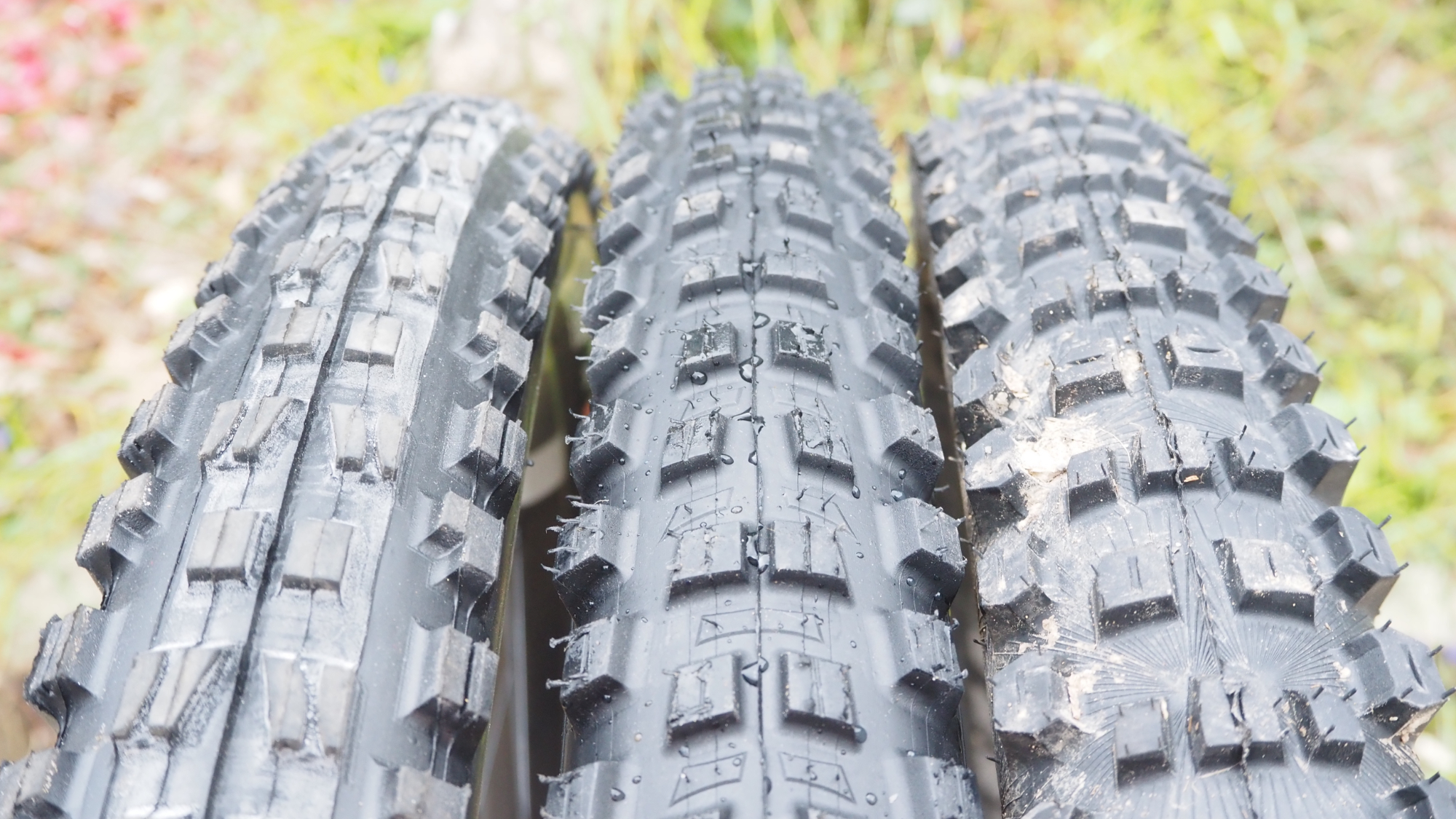Bike Perfect Verdict
Just like the new Wild Enduro MS version I recently tested, this super grippy MH model brings a big overall improvement in performance over previous generation Michelin enduro offerings.
Pros
- +
Tons of predictable and continuous grip
- +
Works well in wet or dry conditions
- +
Tread pattern targets hard pack and rock slabs, but also worked fine everywhere I rode it
- +
Tough, well-damped casing
- +
Faster rolling than previous Wild Enduro
Cons
- -
Blows up a bit too fat and round for how my preferred rear tyre profile
- -
Very expensive compared to something like a Specialized Butcher
- -
Relatively heavy and still only ‘average’ rolling speed
Why trust BikePerfect
It’s clear Michelin’s new Wild Enduro Racing Line range has had more than just a quick freshen-up. The tread patterns not only look completely different, but there’s also a whole new construction and rubber compound used across three different versions. The MH (Mixed/Hard) here and the MS (Mixed/Soft) are primarily designed as front tires, plus there’s also a specific, lower profile, rear model. The trio now weigh less, roll faster, and offer an extra bonus of being designed to work better in colder conditions; this last part something that will be music to the ears of year-round riders in the north especially.
I’ve used the previous generation Wild Enduros and all of Michelin’s gravity tires a fair bit. Since the nineties when it first launched DH-specific tires and brought something of a revolution to MTB grip levels, Michelin has had a great reputation for sticky rubber with great traction, but also for having slower rolling resistance than some other brands. Plus, in the case of its DH tires, it had a very stiff casing with a non-folding wire rather than Kevlar bead. That’s all changed now though, and both this Wild Enduro MH Racing Line and the new DH tires use a folding dual-ply 55tpi carcass.

Design and specifications
This switch from a multi-layered 4-ply casing (that used to be called DH shield) to a dual-ply means the MH is lighter and more supple, while hopefully retaining the sorted puncture protection Michelin is known for. Cut and piercing resistance comes by using two separate woven liner shields and a bead bumper to resist pinch flats and stop the tire bottoming out on a rim wall and getting cut. One of these ‘Kevlar-style’ layers covers just the tread crown and the other wraps the entire inside.
The MH has a pretty ‘standard-looking’ tread, not a million miles from competitors’ patterns, although edge blocks here are slightly alternating/offset in sets of three, which is different to many rivals. Central paddles are laid down in sets of three, with firstly two slightly angled and triangulated blocks, and then a pair of more centrally-aligned knobs that look a lot more like a Maxxis Minion DHR II. The blocks have narrow sipes or cuts on top, but these are shallow compared to many similar tires and don’t look as ready to deform and squirm over harder surfaces.
Michelin’s gap between central and shoulder blocks (that some call a grip channel) is pretty standard too and not as wide as something like a Maxxis Dissector with its definite ‘slip-to-grip’ cornering rail effect. The overall sense on the MH is of quite a lot of rubber laid down, rather than a spiky and spaced-out semi-mud-tire vibe.
Michelin has done more than just changed the tread knobs and casing though. Its latest Magi X rubber is reformulated to offer better performance at lower temperatures down to 3 degrees C. Obviously, that won’t cut it if it’s icy, but hopefully it’s a big improvement on the old Michelin Magi X blend that could get overly stiff and pingy on wet rocks and roots when the thermometer dropped.
This new rubber formula is also supposed to roll significantly faster, and even though it’s slightly more squidgy/smeary when pushed inwards with the old thumb test than the older firmer blend, you also notice is a bit more springy and less slow to deform back into shape. This is presumably why it rolls noticeably faster and while I suspected in my MS review that the rubber blend was harder in this MH tire, after using it, I’d have to guess I was wrong and was likely feeling how the slighter bigger tread blocks deform less when you stick your finger nail into them. The rubber compound definitely isn’t as slow rebounding as before though, but Michelin doesn’t don’t claim exact rubber durometer (hardness levels) like other firms.
One of the easier to spot revisions to the Wild Enduro lineup is you can now buy the best Racing Line models without Michelin’s lairy yellow and black chequered sidewall logos. I’d personally opt for the more subtle new grey logo and reckon it will match more riders’ bikes too. The new Wild Enduro range is quite limited in terms of options compared to some rivals and only comes in 2.5in width in 27.5 or 29in size; there are no casing or rubber compound options like with many rival brands either.
The new tires are lighter with Michelin claiming a 10 percent weight saving; presumably mostly in the switch to the new dual-ply 55TPI construction that “minimizes flexion movement for superior stability when cornering and landing after jumps”. Ten percent lighter doesn’t mean light though considering the previous generation 29in Wild Enduro front was a whopping 1,480g and this MH is 1,330g – that’s still pretty heavy for a tire targeting enduro rather than DH, even if the boundaries of those categories are pretty blurred nowadays.

Performance
I first used this ‘Mixed Hard’ model on the back of a mid-power e-bike in colder/wetter conditions in the early part of the year and then on the front of an enduro bike in warmer/drier conditions. My conclusion from both is I much prefer it on the front, as the slightly big and round profile can feel a bit floaty and slow to cut in when leaning the bike into corners. For a rear tire, I prefer a sharper more precise feel, and also found the MH can be a little bit less sharp and stabby for climbing in the mud and grease where I wheel-spun a few times on the e-bike on steep grassy climbs. (Yes, I know it’s not exactly designed for this).
On the front end, the bigger volume works better to the extent the MH basically rides so much like the MS version that in a blind test, I’d struggle to tell you which model I was riding in the vast majority of conditions. The MS model does have a more open tread that should clear dirt and bite in better in mud and loose conditions, but what this experiment proves to me is that tire grip is much more about rubber and casing than just tread pattern.
Even with a slightly blockier tread you might expect to roll faster, I can’t say I noticed much difference in this department either with the Mixed Hard tire, but considering both share Michelin’s dual-ply casing and Magi X rubber, maybe that shouldn’t be so surprising. Rolling speed is noticeably better than previous generation Wild Enduros though with less of a deadweight, draggy feel.
The Wild Enduro Racing Line casing isn’t as stiff as many DH tires of a similar weight and while it was reasonably solid to install, this MH one went on a little bit easier than the MS and popping into place with a track pump. It also never burped any sealant during testing, even at around 22psi on super rough DH tracks.
Having used the MH both in the wet and dry, it clearly works as intended on hardpack where the shoulder edge holds a smooth line with no surprises or weird breakaway, but also surprises with tenacious grip if you venture off-piste. A few times during testing, I ended up off the sides in the steeps on slimy loamy dirt and Michelin’s touch and predictability at all lean angles is solid, so you never feel too sketchy or skittery. Each individual tread block has a fair bit of support and stiffness, so knobs don’t flex or squirm excessively if you’re really charging on rock hard trail centres or jumps either.
As I said earlier, the crown here is a little bit rounded for my taste to run on the rear, and I’d even prefer it to be a smidge skinnier for the front too for a sharper cut, but Michelin only offers one width of 2.5in that blows up slightly bigger as well on a 30mm internal rim so this might be the tire for riders who like a more precise steering feel.
Michelin’s latest package of casing, tread and compound feels calm and stable on all hits and surfaces and doesn’t bounce around absorbing small hits or big impacts. Landing deep rock steps or fast jumps it supports rider weight without deflecting or buckling (and without being too uncomfortable or overly stiff like the old wire bead Michelin DH 22 and 34 tires were unless running really low pressures). Braking traction is also really good where the tire connects nicely to rough terrain without skipping.
As I said in the MS review, with all its new updates, Michelin has changed the character of the Wild Enduro to the point it rides more like a latest generation Conti or Maxxis. Whether this suits the brand’s core audience that loved the dead, almost ‘medicine ball’ feeling of its previously slappy and slow rebounding formula (at least in warmer weather) is hard for me to say.
Even with the slightly more dynamic and well-damped ride, Michelin has maintained enough support in the casing so sidewalls don’t fold or twist too readily under high cornering loads or landing jumps. And, again, like on the MS, this was backed up visually by no excessive ply lines (light creases) in the casing, despite running around 20psi on the front of a long travel enduro rig on super long and rough tracks. Wear life also seems pretty good, plus I had zero issues here with damaged tread blocks like I did on the MS.
Whether you’d want to buy this MH model or the MS will depend or where you live, but the MS is a little slimmer for extra cornering cut and works better in loose surfaces with minimal penalty on hardpack, so that would probably be my choice as a front Wild Enduro option.

Verdict
Michelin’s new Wild Enduro MH Racing Line has a new tread, rubber compound and casing that completely changes the tire’s character for the better compared to its predecessor. Out goes Michelin’s slow rolling and rebounding compound and eccentric spaced-out edge blocks, and in comes a tire that’s got tons of grip yet is faster, more versatile and designed to work better in cold conditions.
Despite being lighter, the new Wild Enduro seems to carry over Michelin’s excellent puncture resistance, although it’s heavier than other enduro options like Maxxis DD and still as heavy as full-on DH tires from many brands, which is still weight you’ll have to drag uphill whether it turns over easier while rolling or not.
| Attributes | Notes | Rating |
|---|---|---|
| Grip | Excellent predictable traction in the wet or the dry | ★★★★★ |
| Durability | Highly puncture resistant and the softer compound has worn well | ★★★★ |
| Rolling speed | Heavy but faster than the previous version and decent for this tire type | ★★★ |
| Value for money | Pricier than most rivals | ★★★ |
Tech specs: Michelin Wild Enduro MH Racing Line tire
- Price: $101.00 / £79.99 / €80.99
- Weight: 1,330g (29 x 2.5in tested)
- Sizes: 27.5 x 2.5in and 29 x 2.5in
- Options: Dual Ply folding bead (2 x 55tpi plies), Magi X rubber. Chequered or grey logos
- Rival products: Continental Kryptotal, Maxxis Assegai, E*13 Grappler, Specialized Butcher

An ex-elite downhill racer, Mick's been mucking about and occasionally racing mountain bikes for over twenty years. Racing led to photo modelling and testing kit for magazines back in the day, and, nowadays, he's mostly riding enduro-style terrain on conventional and electric bikes. As curious as ever about products and tech, he's as likely to be on the other side of the lens or computer screen rating, reviewing and shooting all the latest gear. Mick's list of regular clients includes Bike Perfect, MBR, MBUK, and most of the leading UK MTB publications at one point or another.

